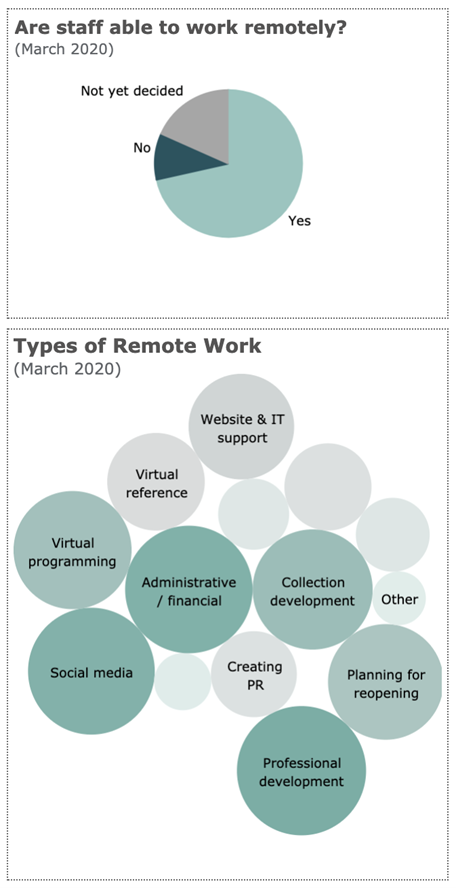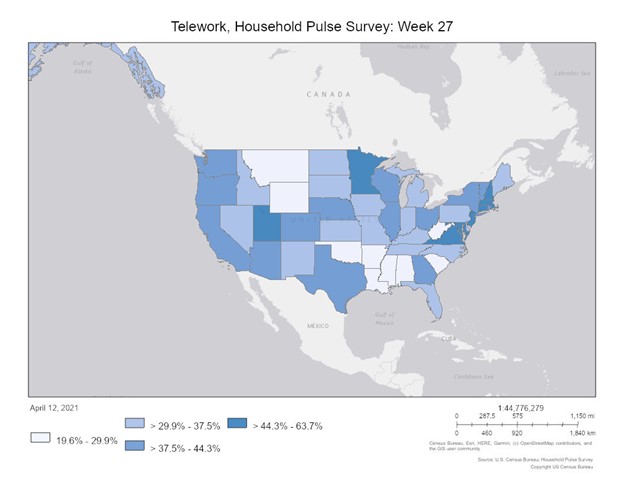The Future of Remote Work is Flexibility
The first article in this series summarized results from PLA’s survey of the public library field in February 2021. Nineteen percent of the survey respondents shared that they feel their library’s policies provide inadequate support for remote work (sometimes referred to as telework, telecommuting, or working from home). Only 34 percent of respondents felt their libraries have done an exceptional job supporting remote work. This post outlines how the outlook for remote work in public libraries has changed during the pandemic, and why it matters now and in the future.

On PLA’s late March 2020 survey of public library responses to COVID-19, 72 percent of libraries said staff could work remotely, 18 percent had not yet decided on remote work policies, and 10 percent said staff could not work remotely, either because the library building remained open or because staff were sent home but could not actually work (visit this link for an interactive version of the chart). This was still very early in the pandemic. For staff working remotely at that time, they primarily engaged in professional development, social media outreach, administrative or financial work, collection development, and planning for reopening.
Over time, as library building closures and changes to access extended beyond the time frame we initially hoped for or anticipated, the types of remote work and related policies evolved. Some libraries that allowed staff to work from home early on ceased to do so once buildings reopened, even with limited access. In other instances, some staff continue to work remotely all or part of the time. One respondent commented that it has been a “tricky balance” trying to provide some safe in-person services, while maintaining flexible scheduling and telework. What began as a stopgap measure has continued in the longer term, and conversations and concerns now center on the extent to which it may continue post-pandemic.

The responses to PLA’s February survey show that a major challenge for remote work in libraries – and other sectors – has been equitable access. To work effectively from home, staff need technology (hardware and software) and internet access. Library staff are part of the communities they serve and like many of those communities, they may not have reliable broadband access or home computers. Libraries also may have suddenly found themselves in need of new virtual platforms and means of accessing or sharing documents. Lack of funding can be a barrier to providing these technologies. It’s also important to recognize that policies for remote work may not be set at the library level if staff are considered city/county employees.
Despite challenges, 34 percent of survey respondents said their libraries have done an exceptional job of supporting remote work. As well as providing technology, two other characteristics stand out in the survey comments: First, during the pandemic they have made remote work an option for all staff regardless of their roles. For some staff this has meant a change in the type of work they do, such as going from working a service desk to responding to a chat service, and that shift has required adjustments. Second, despite “zoom fatigue,” survey respondents valued intentional efforts to maintain connections among staff. This could take the form of regular virtual meetings, creating space for reflection or socializing within those meetings, and more informal means of demonstrating mutual support and care for coworkers.
Cindy Fesemyer serves on the PLA Board of Directors and works at the Wisconsin Department of Public Instruction. She participated in a PLA webinar in April 2020 that addressed ways libraries successfully pivoted to remote work early in the pandemic. A year later, in April 2021, I followed up with her to discuss how the situation has evolved and what the future looks like. As libraries return to in person programs and services, Fesemyer feels that continuing to support some remote work can help libraries bring “our flexibility and our humanity” to workplace policies and practices, helping staff “meet their needs to balance home and work.” Libraries strive to be welcoming spaces, and that should be true for both patrons and staff. Fesemyer hopes that “if we can embrace a more flexible work culture in this way, we can take steps towards increasing the diversity of the workforce as well. When you make allowances for people’s lives, I think that we can start seeing more people having an interest in the profession.”
The sort of remote work library staff – and many other workers – have engaged in during the past year has happened under conditions of crisis. It has served as a temporary safety measure to reduce contact and therefore to reduce the risk of transmitting the virus. Nonetheless, evidence from the past year can inform the future. Being virtual has led public libraries to try new formats for programs and services, and some may continue to offer those. Some staff also found that working from home helped their productivity or reduced their anxiety. The potential value of remote work is not just about being remote, but about new ways of working.
Libraries are patron-facing, so fully remote work is not going to be possible for everyone all the time post-pandemic. However, libraries can still use the lessons of the past year to implement or improve policies going forward. A few principles are worth considering:
- Equity: Policies should apply to all staff. Even if some types of work require more presence in person, there are still options for flexibility. These options should be clearly documented. While in practice, libraries may make accommodations on a case-by-case basis, having a policy in place can reduce bias.
- Support and morale: Managers should model the practices they require of their staff as well as being available to provide support. Even if a manager or administrator’s job could be done fully remotely, doing so could have a negative impact on staff morale and support.
- Productivity and outcomes: Some types of work require focus, which may be difficult to achieve in a library workspace. Rather than micromanaging staff who can’t be “seen” in person, managers can focus on project or program outcomes.
Recognizing the benefits that come with flexible remote work policies can help support staff well-being and improve quality of life. As one survey respondent wrote, “We cannot get through these tough times without considering staff members home-life, and the impact that health and wellness have on productivity and happiness.” That will continue to be true in the future.
Part 3 in this series will discuss how flexibility can help libraries support staff who are caregivers. Stay tuned!
Tags: public library responses to covid-19, remote work in public libraries







